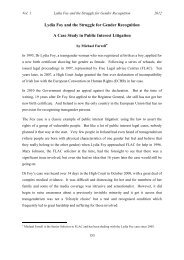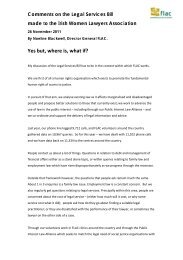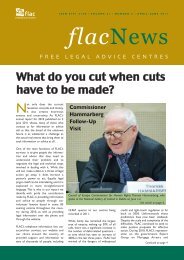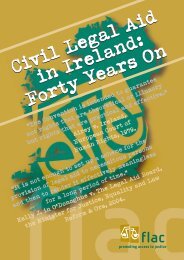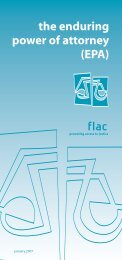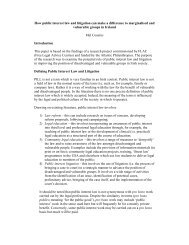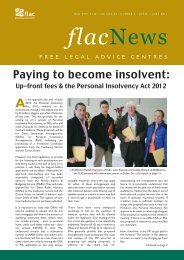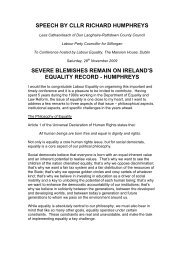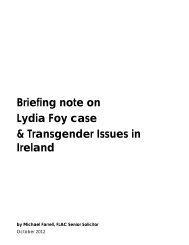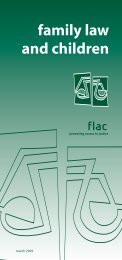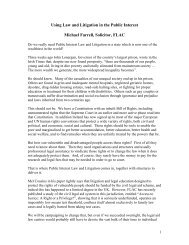Public Interest Litigation as a Tool for Vulnerable Groups: Lessons ...
Public Interest Litigation as a Tool for Vulnerable Groups: Lessons ...
Public Interest Litigation as a Tool for Vulnerable Groups: Lessons ...
Create successful ePaper yourself
Turn your PDF publications into a flip-book with our unique Google optimized e-Paper software.
The cornerstone of remedies <strong>as</strong> provided <strong>for</strong> in the Indian Constitution isexpressed in the language of article 32, 5 which provides a right <strong>for</strong> citizens tomove the Supreme Court <strong>for</strong> any violations of their fundamental rights. 6 Thish<strong>as</strong> resulted in direct petitions to the apex court, and h<strong>as</strong> developed a strongsense of public interest litigation. 7 The relaxation of the rules of locus standiand the fact that there is no limitation on the relief the Courts can provide,h<strong>as</strong> facilitated remedies and procedures. 8 The activism of the Courts 9 h<strong>as</strong> alsoplayed a significant role in emph<strong>as</strong>ising this remedy further. 10 The essentials ofpublic interest litigation in India were summarized by Justice Bhagwati (sincethen a member of the UN Human Rights Committee) in S. P. Gupta:There must be a legal wrong caused to a person or to a determinate cl<strong>as</strong>s ofperson, on whom burden is imposed in violation of law or without legalauthority;The wrong must arise from violation of any constitutional or legal right;The wronged person (or determinate groups of persons) must be unable toapproach the court <strong>for</strong> relief, by re<strong>as</strong>on of –o poverty;oohelplessness; orsocial or economic disability of socially or economicallydisadvantageous position.If the above conditions are satisfactory, then any member of the public canseek judicial redress <strong>for</strong> the above wrong.But the court should be anxious to ensure that the person initiating theproceedings is acting bona fide to get redress <strong>for</strong> a public grievance and notto pursue any personal gain from malicious motives.5 As expressed in Daryao v State of UP AIR 1961 SC 1457, 1461 - fundamental rights are not only inplace to protect individual rights, but are also b<strong>as</strong>ed on public policy, and it w<strong>as</strong> the privilege and dutyof the Court to uphold those rights. The Court had already identified itself <strong>as</strong> the protector andguarantor of fundamental rights in Romesh Thappar v State of Madr<strong>as</strong> AIR 1950 SC 124.6 One of the most famous public interest c<strong>as</strong>es in India also shows the limit of using law from a‘minority’ perspective. In Narmada Bachao Andolan v Union of India, the displacement of population<strong>for</strong> the construction of the dam w<strong>as</strong> challenged. The Court held that the displacement did not violatefundamental rights; instead it analysed whether rehabilitation at newer locations made them better off,and satisfied itself that the new facilities were better than those enjoyed in the tribal hamlets, ruling thatgradual <strong>as</strong>similation into mainstream society would lead to betterment and progress see AIR 2000 SC3751.7 For more on the scope of public interest litigation <strong>as</strong> enunciated by the Courts themselves see S. P.Gupta v Union of India, AIR 1982 SC 149, 194.8 Especially D. C. Wadhwa v State of Bihar, AIR 1987 SC 579, para 38 and Fertilizer Corporation vUnion of India, AIR 1981 SC 344.9 Commenting on the occ<strong>as</strong>ion of 50 th Anniversary of the Indian Supreme Court, Dr Adarsh SeinAnand, CJ stated: …[The Court] h<strong>as</strong>, intervened to protect democracy and the rule of law… guided bythe Latin boni judicis est ampliare jurisdictionem (law must keep pace with society to retain itsrelevance)… to create a civil society in which respect <strong>for</strong> human dignity is the corner-stone of it’sfunctioning, the Supreme Court h<strong>as</strong> zealously protected the human rights of individuals… In expandingthe ambit of the right to life and personal liberty, the Court h<strong>as</strong> evolved compensatory jurisprudence,implemented international conventions and treaties, and issued directions <strong>for</strong> environmental justice. Ith<strong>as</strong> given directions, and also prescribed guidelines <strong>for</strong> the en<strong>for</strong>cement and achievement of humanrights of various groups such <strong>as</strong> children, women, disabled, scheduled c<strong>as</strong>tes, scheduled tribes, bondedlabourers, minorities, and socially and economically backward cl<strong>as</strong>ses’, <strong>for</strong>eword in V Kusum (n 9above) vi.10 SP Sathe Judicial Activism and the Indian Supreme Court (2002).4



